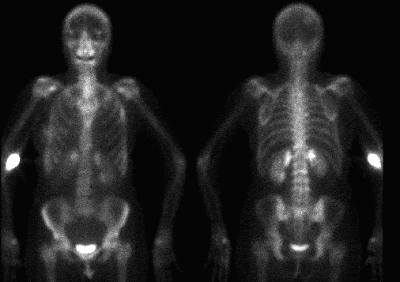
Breast cancer is one of the top cancers in women today. Most of us would know someone who has, or has had breast cancer, and with the ongoing media coverage of the condition, women are becoming increasingly aware of the condition. National breast screening programmes, dedicated breast clinics, advances in modern treatment methods together with ongoing research, all play their part in the early detection and successful treatment.
What is Cancer?
Cells throughout the body are continually being lost and replaced, occuring in a state of balance. If, for some reason, the control mechanisms ensuring this balance become disrupted, a cell may start multiplying out of control - a tumour is then born.
Tumours are classified into whether they are benign or malignant. Benign tumours are those which, whilst growing in a uncontrolled manner, do not spread beyond the confines of their anatomical boundaries. Malignant tumours, on the other hand, are those which have the ability to invade structures and thereby enabling them to spread beyond their anatomical boundaries. They are also able to spread to distant parts of the body by invading the blood and lymphatic systems. The characteristic feature shared by all cancers is that this usual balance between cell loss and cell multiplication is disrupted.
What are the Risk Factors for developing Breast Cancer?
Some women with one, or even a few risk factors, never go on to develop breast cancer, whilst there are many women with breast cancer who have no apparent risk factors.
The Following are known risk factors:
• Having had cancer in one breast: this increases 3 to 4 fold, the risk of developing a new breast cancer, unrelated to the first, in the other breast, or in another part of the same breast.
• Getting older: the risk of breast cancer increases with age, the peak incidence occurring in the 55 to 59 age group. Whilst breast cancer predominantly affects older women, it can occur in women under 30 years of age.
• Family history of breast cancer: having a first degree relative (mother, sister or daughter) with breast cancer increases your risk of having breast cancer yourself.
• Predisposing breast conditions: history of certain breast conditions, such as atypical lobular or ductal hyperplasia, and lobar carcinoma in-situ, increases the risk of developing breast cancer.
• Genetics: carriers of alterations of the BRCA1 or BRCA2 genes are at higher risk of developing breast cancer. Women suspected to have genetic risk for breast cancer should undergo genetic risk assessment by a specialist (ideally in a cancer genetics clinic). Women with this BRCA mutation have about a 5 - 10 times increased risk for developing breast cancer compared to women without this mutation. They also tend to present with breast cancer at a much earlier age.
• Being Overweight
• Alcohol intake
• Race: caucasian women have been found to be at slightly higher risk of developing breast cancer than their African-American, Hispanic, Native American and Asian counterparts.
• Presence of other cancers in the family: a positive family history of cancers of the ovaries, uterus, cervix or colon increases the risk of you developing breast cancer.
• Excessive exposure to radiation
• Hormone Replacement Therapy (HRT): long term use of combined oestrogen and progesterone increases the risk of breast cancer.
• Late childbirth: having your first child after the age of 35 or never having children increases your risk of breast cancer.
• Early menarche: if you had your first period before the age of 12 years, your risk is increased.
• Late menopause: if you reach menopause very late, this would also increase your risk of breast cancer.
What are the Symptoms?
Breast cancer, in its early stages, usually has no symptoms. As the tumour grows, some of the following symptoms may be noticed:
• Lump in the breast or underarm that does not change in size with your mensus. Lumps due to breast cancer are typically painless.
• Changes in the colour or skin of the breast, areola or nipple (e.g. puckering, dimpling or scaling)
• Change in the nipple, such as retraction (pulled in nipple), itching or burning sensation, or discharge from the nipple.
• A marble-like hardened area under the skin of the breast.
• Change in the size or shape of the breast
What Can Help Decrease the Risk of Developing Breast Cancer?
A healthy balanced diet, regular exercise, maintaining a healthy weight, and avoiding over-consumption of alcohol, will help decrease the chances of developing breast cancer, along with a host of other diseases. Minimizing the use of Hormone Replacement Therapy to as short a time as possible will also minimize risk.
Having regular screening mammograms will not decrease the risk of developing breast cancer, but it enables the best chance of early detection, where treatment is generally more successful.
How is Breast Cancer Diagnosed?
Many women present to their doctors with breast symptoms which do not turn out to be due to cancer. Common benign conditions of the breast include fibroadenomas and fibrocystic disease of the breast. However, all new breast changes should be evaluated by a doctor.
Doctors generally make the diagnosis of breast cancer by employing what is commonly known as the "Triple Test". As its name suggests, there are three parts to it:
(i) Clinical Examination
(ii) Imaging of the Breast
(iii) Breast Biopsy
1. Clinical Examination
Breast examination by a doctor involves inspecting and palpation of all 4 quadrants (the breast is typically categorized into 4 parts) of both breasts, the area under the nipples, and under both arms to feel for lymph node enlargement.
2. Imaging of the Breast
Mammography is the commonest test used to detect breast cancer. In younger women who tend to have much denser breast tissue, mammograms may be difficult to read and doctors may request for other imaging methods instead.
Benign breast lumps are typically rounded with smooth edges. Cancers, by contrast, usually appear denser with an irregular edge. The surrounding tissue may also be distorted by invading cancer cells. Cancers may also be associated clusters of calcium flecks which show up on mammograms as bright white dots.
Ultrasound of the breast is a good way to focus on areas of the breast which are of particular concern, such as in a region where a lump is felt. It is also frequently done in younger women with denser breast tissue in whom mammograms may not be suitable.
MRIs are sometimes used to assist in the screening of women at high risk of breast cancer, obtaining more detailed assessment of an area of particular concern found on mammogram or ultrasound, as well as in the monitoring for recurrence after treatment.
3. Breast Biopsy
Fine-Needle Aspiration
Fine-needle aspiration (FNA) involves collecting a small sample of breast tissue using a long, thin needle and a syringe. FNAs are done under local anaesthesia. Mammograms or ultrasounds are often used to help locate the area of concern. Cells aspirated are then sent to a pathology laboratory for staining and interpretation.
Core / Mammotome Biopsy
This is similar to the FNA, however, in this case a much larger needle is used to obtain a "worm" of breast tissue rather than just some cells as in that obtained by an FNA. The core biopsy is also done under local anaesthesia and it gives doctors more breast tissue to work on, increasing the accuracy of diagnosis.
Open Surgical Biopsy
This requires a cut in the skin, in order to remove a sample of the lump, or sometimes, the entire lump. This method, whilst being the most accurate method of differentiating benign from cancerous lesions, is a lot more invasive than the previously discussed methods.
Your breast surgeon will advise you on the most appropriate method for obtaining a biopsy sample for you.
Factors Which Affect Prognosis:
Several factors are know to affect the likelihood of successful treatment and the risk of recurrence.
These would include the following:
• The stage of the cancer (size of tumour, whether it has spread to the lymph nodes or to other parts of the body)
• The type of breast cancer (eg. tubular, mucinous, papillary)
• Whether the tumour is hormone receptor (estrogen/progesterone receptors) positive or negative
• Histological grade
• Human epidermal growth factor type 2 receptor (HER2) gene amplification and/or overexpression
• Whether the tumour is a new one or a recurrence
• The age, menopausal status and general health of the woman
Treatment:
Surgery is considered to be the primary treatment of breast cancer and many patients with early breast cancer are cured by surgery alone. Surgery aims to completely remove the tumour, as well as to achieve clear resection margins, in order to reduce the risk of tumour recurrence. Several types of surgery are performed (eg. mastectomy, lumpectomy) but these will not be discussed in this article.
Adjuvant therapy is designed to treat micrometastatic disease (cancer cells which have escaped the breast and regional lymph nodes, and which have not yet had an established identifiable metastatic focus). It is given after primary therapy to increase the long-term disease-free survival.
Types of adjuvant therapy include chemotherapy, hormonal therapy, radiation therapy and targeted therapy with monoclonal antibodies.
Dr Ang C.D. has been in medical practice for over 12 years. He graduated with an M.B.B.S. degree from the National University of Singapore in 1997 and subsequently completed his post-graduate diploma in Family Medicine.
He has had training in Emergency Medicine, Internal Medicine, Geriatric Medicine, Orthopaedic Surgery, Obstetrics & Gynaecology, Neurosurgery, General Surgery, Colorectal Surgery and Urology.
Dr Ang currently practices in a family clinic in Singapore, seeing a good mix of paediatric, adult and geriatric patients.
With the goal of providing local and international patients with a resource for specialist care in Singapore, Dr Ang has founded SingaporeDoc.com, a Web Directory of Specialists in Private Practice in Singapore. http://www.singaporedoc.com
By Dr Ang C. D.

























